Verdict
Some niggling start-up issues aside, the Helm Bolt is a satisfying plug-and-play DAC that’s available for a relatively inexpensive amount. Its headline feature of MQA has been mitigated by Tidal’s recent move to FLAC, but PC and Android users will still be able to benefit from MQA rendering from the Helm Bolt.
Pros
- Transparent, balanced performance
- Compact size for mobile use
- Plug and play operation
- Affordable price
Cons
- Some start-up issues mar its performance
- A little short of detail and sharpness
-
MQA rendererCan complete the unfold require for higher quality MQA playback -
THX certifiedCertified to play audio with low distortion and reduction in crosstalk -
ImpedanceAutomatically senses headphones’ impedance and sets the level required
Introduction
These days there are plenty of ways to improve your audio experience. You could subscribe to a high-quality service music, but that only achieves part of what you need. To complete the circle, you’ll need a DAC.
And with the Helm Bolt DAC, it’s a digital-to-analogue converter that aims to give your audio a big boost without the need for a big investment as it’s now available for just shy of £100 / $100. This puts it alongside the likes of the Earmen Eagle, a DAC I liked a lot when I reviewed it. Can the Helm Bolt best its performance?
Design
- Compact design
- LED indicator for sampling rate
- USB-A adapter
The number of plug-and-play DACs in the market has grown in popularity recently, the kind of small, convenient amplifier that could be used at home but easily taken outside of the house with a mobile device.
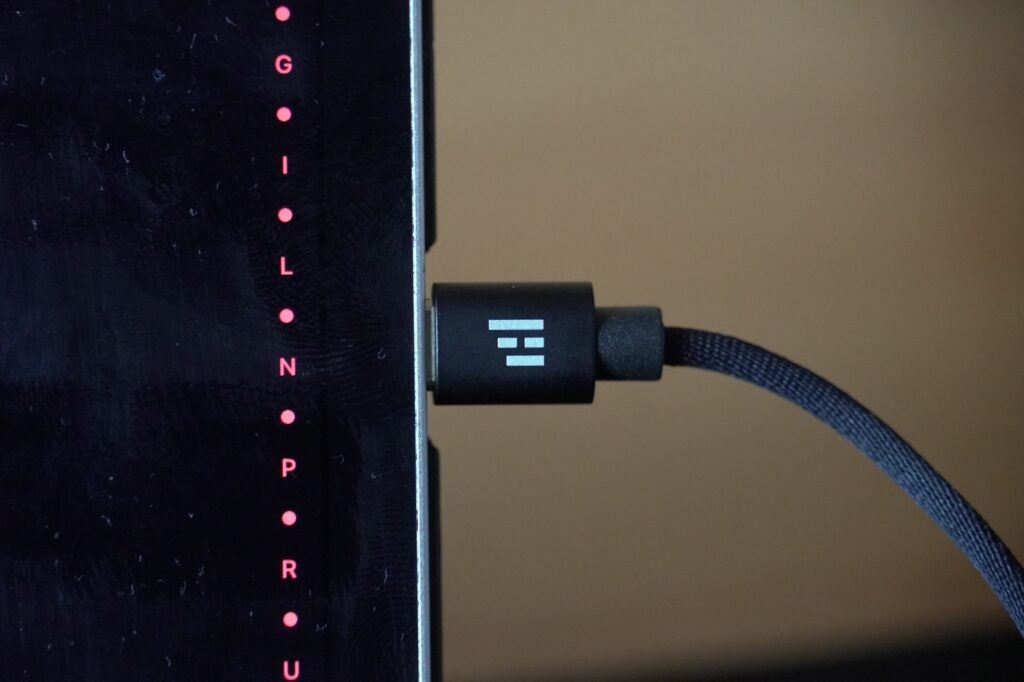
The Helm Bolt is one such DAC. It’s small at only 95mm long and a width of 11.7mm, with a compact main housing that connects to USB-C input via a flexible cable. It’s much smaller than a comparable plug-and-play DAC like the Astell & Kern HC3.
The build quality is good for its small proportions, the flexible cable gives some leeway if you’re connecting to a source in a tight space, and it comes with a USB-A adapter to connect to a laptop, PC, or non-USB-C-compliant source. It’s only big enough to include a 3.5mm output to hook up a wired headphone.
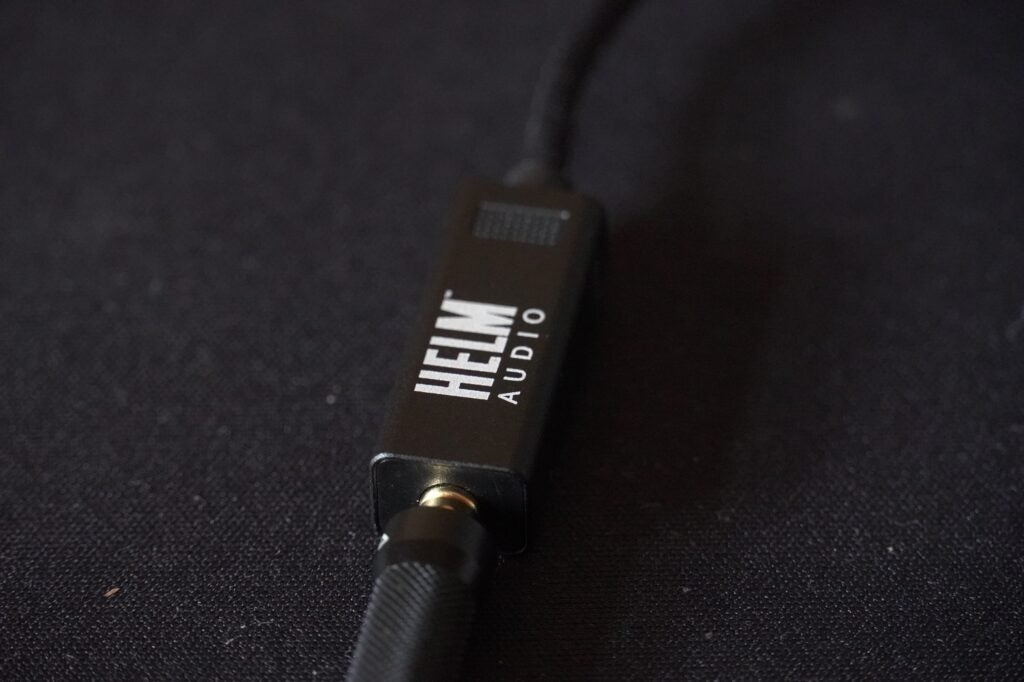
There’s an LED that showcases file type and frequency sampling rate, as well as a soft carry pouch for transport, and that’s it for the Helm Bolt DAC’s design. It keeps things simple, which will appeal to those interested in boosting audio with minimum fuss.
Features
- MQA renderer support
- THX certification for low distortion/crosstalk
- DAC protected from electromagnetic interference
The LED shows three types of file/sampling rate. Purple is MQA, used by the likes of Tidal music streaming. Red refers to HD tracks greater than 48kHz, and Blue equals SD tracks up to 48kHz. The Helm Bolt can playback PCM and DSD up to 384kHz and 5.6MHz respectively.
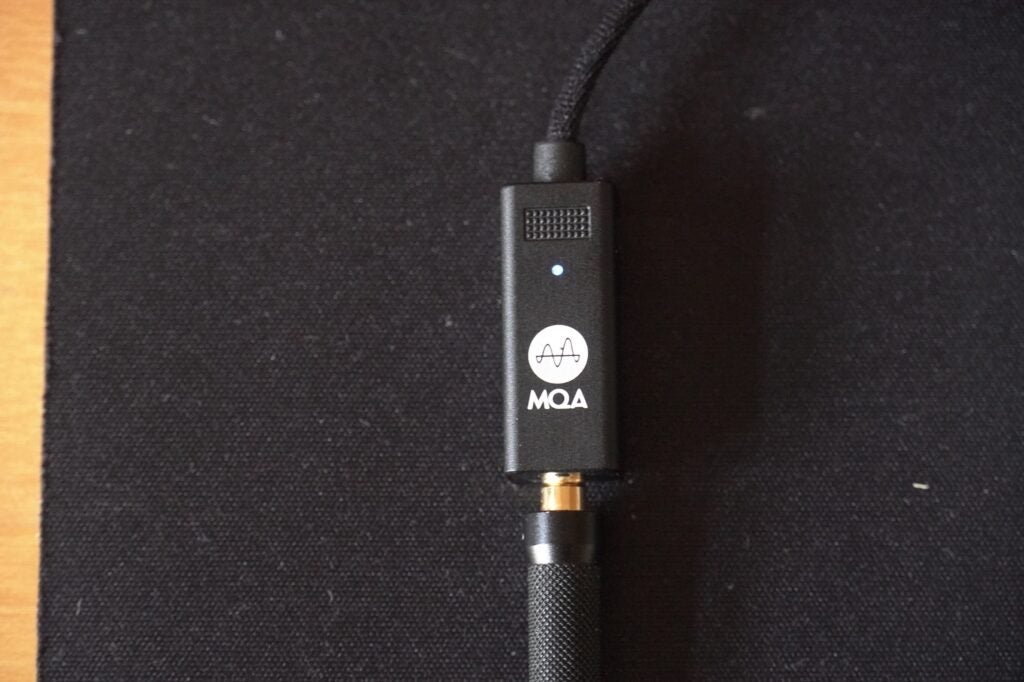
The Bolt uses an ESS Sabre DAC with a three-oscillator design claimed to be better than a single oscillator design due to its “superior frequency lock”. The DAC is positioned in a shielded headphone connector for optimal EMI (electromagnetic interference) to isolate it from the USB and reduce crosstalk distortion (where a signal on one channel leaks into another). The shielded cable also helps to improve the conductivity of the signal from source to the DAC as well as isolate from EMI.
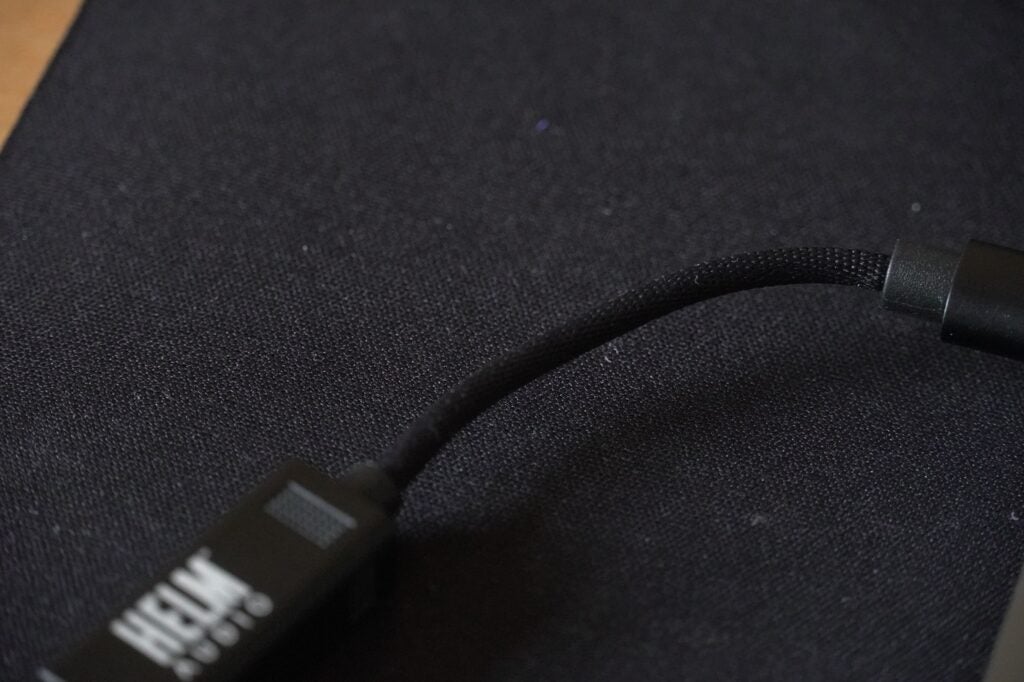
It’ll also automatically decipher a headphone’s impedance and set the output levels, either at 1V for headphones’ impedance at less than 150ohms or 2V for more than 150ohms.
There is THX certification (like the THX Onyx), and compatibility for Android and iOS mobile devices, as well as macOS and Windows 10. The Helm Bolt acts as a renderer for MQA music files, so when paired with a decoder (the Tidal app), the Helm Bolt can perform the final ‘unfold’ and unlock the information within the MQA stream for the highest quality playback.
Performance
- Transparent sound
- Balanced but dynamic performance
- Niggly start-up issues
A slightly peculiar trait I’ve noticed with the Helm Bolt DAC is that it doesn’t always play audio when connected. Whether it’s a compatibility issue or the DAC not fully operating, I’m not sure. It has a mind of its own, working fine on some occasions or refusing to on others, the system recognising it as “ESS USB Audio” instead of “Helm MQA”. It can be very fussy.
But catch it on a good day – you can tell it’s in the mood when it goes through its proper start-up sequence of red/blue flashing lights – and the Helm Bolt DAC strikes a transparent and balanced tone with audio played through a Sivga Robin SV021. There’s no obvious attempt of the DAC to add or alter the audio signal through processing whether through warmth or crispness. It feels that what I hear is coming straight from the music streamer’s servers as intended.
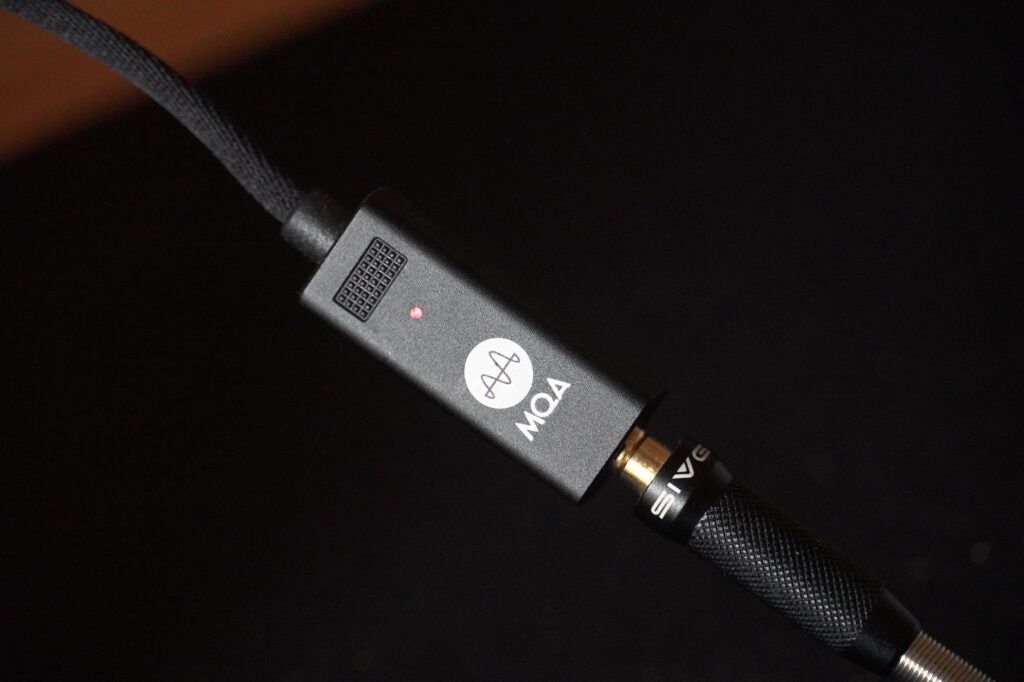
Take a track like Bear McCreary’s Rodan from the Godzilla: King of the Monsters soundtrack (Tidal) where there’s plenty of energy to the percussive beats, a surging forward momentum and large-scale dynamics, and the Helm Bolt reproduces it in an unflustered manner. The drumbeats carry plenty of weight and power but not in a manner where it becomes the focus of the track.
The sense of surging momentum is carried well through the song, though perhaps with not as much clarity or detail as expected – with some tracks Tidal sounds warmer than other services, and a subsequent listen on Apple Music reveals a sharper sense of detail and clarity, as well as a better sense of small and larger scale harmonics, plus a wider soundstage to indulge in.
But that speaks to what I wrote earlier in that the Helm Bolt doesn’t add its own characteristics, it simply accentuates whatever is provided in the stream.
With Avishai Cohen and Big Vicious’ Hidden Chamber (Tidal), there’s a pleasing richness the Helm Bolt extracts from Cohen’s trumpet performance. It also exerts tight control over the song’s dynamics, astutely capturing the smaller, quieter moments that allow the more expressive parts to stand out more. It’s a presentation that sounds fluid, dynamic, and lively, but also natural.
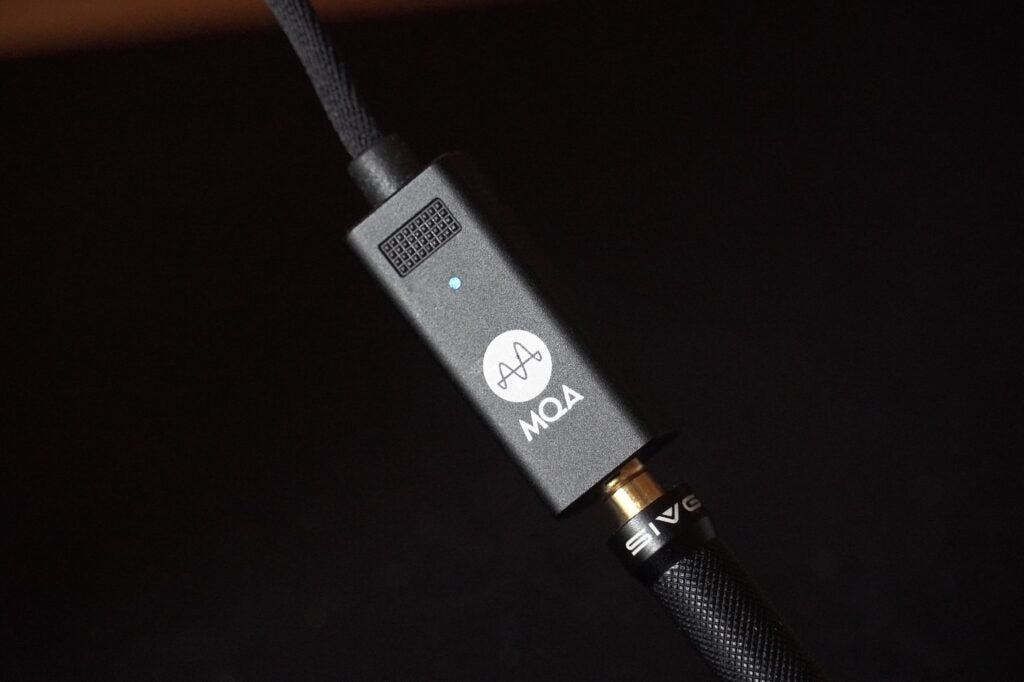
With Tidal adding FLAC to its service, it’s become harder to find MQA files, in particular on iOS, which rather nullifies the headline feature of this DAC in 2023. A switch to PC and a listen to Air’s Alone in Kyoto presents the same sort of control as before with regards to track’s dynamics.
The brightness of the high frequency notes is brought out with some nice extension and clarity: there’s a good firmness to the piano notes, the width of the soundstage is nicely described, while the waves that crash in the background towards the track’s end add neatly to the track’s overall ambience. The Helm Bolt knits it together in an effortless manner. It does leave some detail and sharpness on the table when compared to the Earmen Eagle, which if I were to choose between the two, the Eagle would be my preferred option.
Latest deals
Should you buy it?
It’s plug and play simplicity
The Helm Bolt DAC is exceedingly simple to use with its plug and play operation that lets you get on with enjoying your music.
Niggling start-up issues
It works fine with the Windows PC, Android, and iOS devices I’ve connected it to, but there are other occasions where it just doesn’t want to work.
Final Thoughts
As a portable DAC the Helm Bolt works effectively to amplify audio without leaving any obvious trace of processing. It’s simple to use, and its plug-and-play operation means you can get straight to listening to music without fuss.
Or at least there wouldn’t be fuss if it weren’t for some niggling start-up issues that end up with no sound played. The Helm Bolt went on sale in 2020, and this issue doesn’t seem to have been resolved. What the root of it is I’m not sure, but it’s frequent enough to irritate. I have found connecting the Bolt to a device via the USB-A adapter or just plugging it in and out can remedy the issue, but not always.
Nevertheless, if you want to extract a better performance from your music streaming experience, the Helm Bolt is a good and affordable choice. The benefit of having MQA has been whittled down, but whichever music service you subscribe to, the Helm Bolt will help extract a higher quality performance than without it.
How we test
We test every DAC we review thoroughly over an extended period of time. We use industry-standard tests to compare features properly. We’ll always tell you what we find. We never, ever, accept money to review a product.
Find out more about how we test in our ethics policy
Tested with multiple streaming services
FAQs
Yes you could as this is a plug and play DAC with a USB-C connection. Those with older iPhones will have to use the Lightning to USB-C adapter to connect.
Verdict
Some niggling start-up issues aside, the Helm Bolt is a satisfying plug-and-play DAC that’s available for a relatively inexpensive amount. Its headline feature of MQA has been mitigated by Tidal’s recent move to FLAC, but PC and Android users will still be able to benefit from MQA rendering from the Helm Bolt.
Pros
- Transparent, balanced performance
- Compact size for mobile use
- Plug and play operation
- Affordable price
Cons
- Some start-up issues mar its performance
- A little short of detail and sharpness
-
MQA rendererCan complete the unfold require for higher quality MQA playback -
THX certifiedCertified to play audio with low distortion and reduction in crosstalk -
ImpedanceAutomatically senses headphones’ impedance and sets the level required
Introduction
These days there are plenty of ways to improve your audio experience. You could subscribe to a high-quality service music, but that only achieves part of what you need. To complete the circle, you’ll need a DAC.
And with the Helm Bolt DAC, it’s a digital-to-analogue converter that aims to give your audio a big boost without the need for a big investment as it’s now available for just shy of £100 / $100. This puts it alongside the likes of the Earmen Eagle, a DAC I liked a lot when I reviewed it. Can the Helm Bolt best its performance?
Design
- Compact design
- LED indicator for sampling rate
- USB-A adapter
The number of plug-and-play DACs in the market has grown in popularity recently, the kind of small, convenient amplifier that could be used at home but easily taken outside of the house with a mobile device.

The Helm Bolt is one such DAC. It’s small at only 95mm long and a width of 11.7mm, with a compact main housing that connects to USB-C input via a flexible cable. It’s much smaller than a comparable plug-and-play DAC like the Astell & Kern HC3.
The build quality is good for its small proportions, the flexible cable gives some leeway if you’re connecting to a source in a tight space, and it comes with a USB-A adapter to connect to a laptop, PC, or non-USB-C-compliant source. It’s only big enough to include a 3.5mm output to hook up a wired headphone.

There’s an LED that showcases file type and frequency sampling rate, as well as a soft carry pouch for transport, and that’s it for the Helm Bolt DAC’s design. It keeps things simple, which will appeal to those interested in boosting audio with minimum fuss.
Features
- MQA renderer support
- THX certification for low distortion/crosstalk
- DAC protected from electromagnetic interference
The LED shows three types of file/sampling rate. Purple is MQA, used by the likes of Tidal music streaming. Red refers to HD tracks greater than 48kHz, and Blue equals SD tracks up to 48kHz. The Helm Bolt can playback PCM and DSD up to 384kHz and 5.6MHz respectively.

The Bolt uses an ESS Sabre DAC with a three-oscillator design claimed to be better than a single oscillator design due to its “superior frequency lock”. The DAC is positioned in a shielded headphone connector for optimal EMI (electromagnetic interference) to isolate it from the USB and reduce crosstalk distortion (where a signal on one channel leaks into another). The shielded cable also helps to improve the conductivity of the signal from source to the DAC as well as isolate from EMI.

It’ll also automatically decipher a headphone’s impedance and set the output levels, either at 1V for headphones’ impedance at less than 150ohms or 2V for more than 150ohms.
There is THX certification (like the THX Onyx), and compatibility for Android and iOS mobile devices, as well as macOS and Windows 10. The Helm Bolt acts as a renderer for MQA music files, so when paired with a decoder (the Tidal app), the Helm Bolt can perform the final ‘unfold’ and unlock the information within the MQA stream for the highest quality playback.
Performance
- Transparent sound
- Balanced but dynamic performance
- Niggly start-up issues
A slightly peculiar trait I’ve noticed with the Helm Bolt DAC is that it doesn’t always play audio when connected. Whether it’s a compatibility issue or the DAC not fully operating, I’m not sure. It has a mind of its own, working fine on some occasions or refusing to on others, the system recognising it as “ESS USB Audio” instead of “Helm MQA”. It can be very fussy.
But catch it on a good day – you can tell it’s in the mood when it goes through its proper start-up sequence of red/blue flashing lights – and the Helm Bolt DAC strikes a transparent and balanced tone with audio played through a Sivga Robin SV021. There’s no obvious attempt of the DAC to add or alter the audio signal through processing whether through warmth or crispness. It feels that what I hear is coming straight from the music streamer’s servers as intended.

Take a track like Bear McCreary’s Rodan from the Godzilla: King of the Monsters soundtrack (Tidal) where there’s plenty of energy to the percussive beats, a surging forward momentum and large-scale dynamics, and the Helm Bolt reproduces it in an unflustered manner. The drumbeats carry plenty of weight and power but not in a manner where it becomes the focus of the track.
The sense of surging momentum is carried well through the song, though perhaps with not as much clarity or detail as expected – with some tracks Tidal sounds warmer than other services, and a subsequent listen on Apple Music reveals a sharper sense of detail and clarity, as well as a better sense of small and larger scale harmonics, plus a wider soundstage to indulge in.
But that speaks to what I wrote earlier in that the Helm Bolt doesn’t add its own characteristics, it simply accentuates whatever is provided in the stream.
With Avishai Cohen and Big Vicious’ Hidden Chamber (Tidal), there’s a pleasing richness the Helm Bolt extracts from Cohen’s trumpet performance. It also exerts tight control over the song’s dynamics, astutely capturing the smaller, quieter moments that allow the more expressive parts to stand out more. It’s a presentation that sounds fluid, dynamic, and lively, but also natural.

With Tidal adding FLAC to its service, it’s become harder to find MQA files, in particular on iOS, which rather nullifies the headline feature of this DAC in 2023. A switch to PC and a listen to Air’s Alone in Kyoto presents the same sort of control as before with regards to track’s dynamics.
The brightness of the high frequency notes is brought out with some nice extension and clarity: there’s a good firmness to the piano notes, the width of the soundstage is nicely described, while the waves that crash in the background towards the track’s end add neatly to the track’s overall ambience. The Helm Bolt knits it together in an effortless manner. It does leave some detail and sharpness on the table when compared to the Earmen Eagle, which if I were to choose between the two, the Eagle would be my preferred option.
Latest deals
Should you buy it?
It’s plug and play simplicity
The Helm Bolt DAC is exceedingly simple to use with its plug and play operation that lets you get on with enjoying your music.
Niggling start-up issues
It works fine with the Windows PC, Android, and iOS devices I’ve connected it to, but there are other occasions where it just doesn’t want to work.
Final Thoughts
As a portable DAC the Helm Bolt works effectively to amplify audio without leaving any obvious trace of processing. It’s simple to use, and its plug-and-play operation means you can get straight to listening to music without fuss.
Or at least there wouldn’t be fuss if it weren’t for some niggling start-up issues that end up with no sound played. The Helm Bolt went on sale in 2020, and this issue doesn’t seem to have been resolved. What the root of it is I’m not sure, but it’s frequent enough to irritate. I have found connecting the Bolt to a device via the USB-A adapter or just plugging it in and out can remedy the issue, but not always.
Nevertheless, if you want to extract a better performance from your music streaming experience, the Helm Bolt is a good and affordable choice. The benefit of having MQA has been whittled down, but whichever music service you subscribe to, the Helm Bolt will help extract a higher quality performance than without it.
How we test
We test every DAC we review thoroughly over an extended period of time. We use industry-standard tests to compare features properly. We’ll always tell you what we find. We never, ever, accept money to review a product.
Find out more about how we test in our ethics policy
Tested with multiple streaming services
FAQs
Yes you could as this is a plug and play DAC with a USB-C connection. Those with older iPhones will have to use the Lightning to USB-C adapter to connect.
























